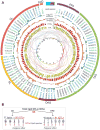Systems Analyses Reveal Physiological Roles and Genetic Regulators of Liver Lipid Species
- PMID: 29909277
- PMCID: PMC6054463
- DOI: 10.1016/j.cels.2018.05.016
Systems Analyses Reveal Physiological Roles and Genetic Regulators of Liver Lipid Species
Abstract
The genetics of individual lipid species and their relevance in disease is largely unresolved. We profiled a subset of storage, signaling, membrane, and mitochondrial liver lipids across 385 mice from 47 strains of the BXD mouse population fed chow or high-fat diet and integrated these data with complementary multi-omics datasets. We identified several lipid species and lipid clusters with specific phenotypic and molecular signatures and, in particular, cardiolipin species with signatures of healthy and fatty liver. Genetic analyses revealed quantitative trait loci for 68% of the lipids (lQTL). By multi-layered omics analyses, we show the reliability of lQTLs to uncover candidate genes that can regulate the levels of lipid species. Additionally, we identified lQTLs that mapped to genes associated with abnormal lipid metabolism in human GWASs. This work provides a foundation and resource for understanding the genetic regulation and physiological significance of lipid species.
Keywords: BXD; cardiolipin; fatty liver; genetic reference population, GRP; genetic variation; genome-wide association study, GWAS; lipid species; lipidomics; non-alcoholic fatty liver disease, NAFLD; quantitative trait locus, QTL.
Copyright © 2018 The Authors. Published by Elsevier Inc. All rights reserved.
Conflict of interest statement
The authors declare no competing interests.
Figures






Similar articles
-
Genetic Regulation of Plasma Lipid Species and Their Association with Metabolic Phenotypes.Cell Syst. 2018 Jun 27;6(6):709-721.e6. doi: 10.1016/j.cels.2018.05.009. Epub 2018 Jun 13. Cell Syst. 2018. PMID: 29909275 Free PMC article.
-
Detection of differentially expressed candidate genes for a fatty liver QTL on mouse chromosome 12.BMC Genet. 2016 Jun 6;17(1):73. doi: 10.1186/s12863-016-0385-2. BMC Genet. 2016. PMID: 27266874 Free PMC article.
-
Identification of eQTLs for hepatic Xbp1s and Socs3 gene expression in mice fed a high-fat, high-caloric diet.G3 (Bethesda). 2015 Jan 23;5(4):487-96. doi: 10.1534/g3.115.016626. G3 (Bethesda). 2015. PMID: 25617409 Free PMC article.
-
Metabolic dysfunction-associated fatty liver disease: advances in genetic and epigenetic implications.Curr Opin Lipidol. 2022 Apr 1;33(2):95-102. doi: 10.1097/MOL.0000000000000814. Curr Opin Lipidol. 2022. PMID: 34966133 Review.
-
Cross-species data integration to prioritize causal genes in lipid metabolism.Curr Opin Lipidol. 2021 Apr 1;32(2):141-146. doi: 10.1097/MOL.0000000000000742. Curr Opin Lipidol. 2021. PMID: 33651746 Free PMC article. Review.
Cited by
-
Genetic regulation of liver lipids in a mouse model of insulin resistance and hepatic steatosis.Mol Syst Biol. 2021 Jan;17(1):e9684. doi: 10.15252/msb.20209684. Mol Syst Biol. 2021. PMID: 33417276 Free PMC article.
-
Mouse Systems Genetics as a Prelude to Precision Medicine.Trends Genet. 2020 Apr;36(4):259-272. doi: 10.1016/j.tig.2020.01.004. Epub 2020 Feb 6. Trends Genet. 2020. PMID: 32037011 Free PMC article. Review.
-
Morc4 is a novel functional gene associated with lipid metabolism in BXD recombinant inbred population.Front Cardiovasc Med. 2025 Jun 18;12:1570729. doi: 10.3389/fcvm.2025.1570729. eCollection 2025. Front Cardiovasc Med. 2025. PMID: 40606021 Free PMC article.
-
Changes of cardiolipin involve in the occurrence and development of mitochondrial dysfunction associated with non-alcoholic fatty liver disease.Zhong Nan Da Xue Xue Bao Yi Xue Ban. 2021 Jun 28;46(6):653-657. doi: 10.11817/j.issn.1672-7347.2021.200583. Zhong Nan Da Xue Xue Bao Yi Xue Ban. 2021. PMID: 34275935 Free PMC article. Chinese, English.
-
Mechanisms Behind NAFLD: a System Genetics Perspective.Curr Atheroscler Rep. 2023 Nov;25(11):869-878. doi: 10.1007/s11883-023-01158-3. Epub 2023 Oct 9. Curr Atheroscler Rep. 2023. PMID: 37812367 Review.
References
Publication types
MeSH terms
Substances
Grants and funding
LinkOut - more resources
Full Text Sources
Other Literature Sources
Molecular Biology Databases

